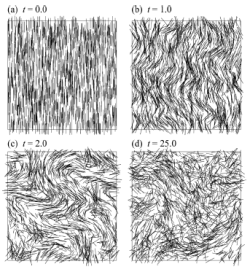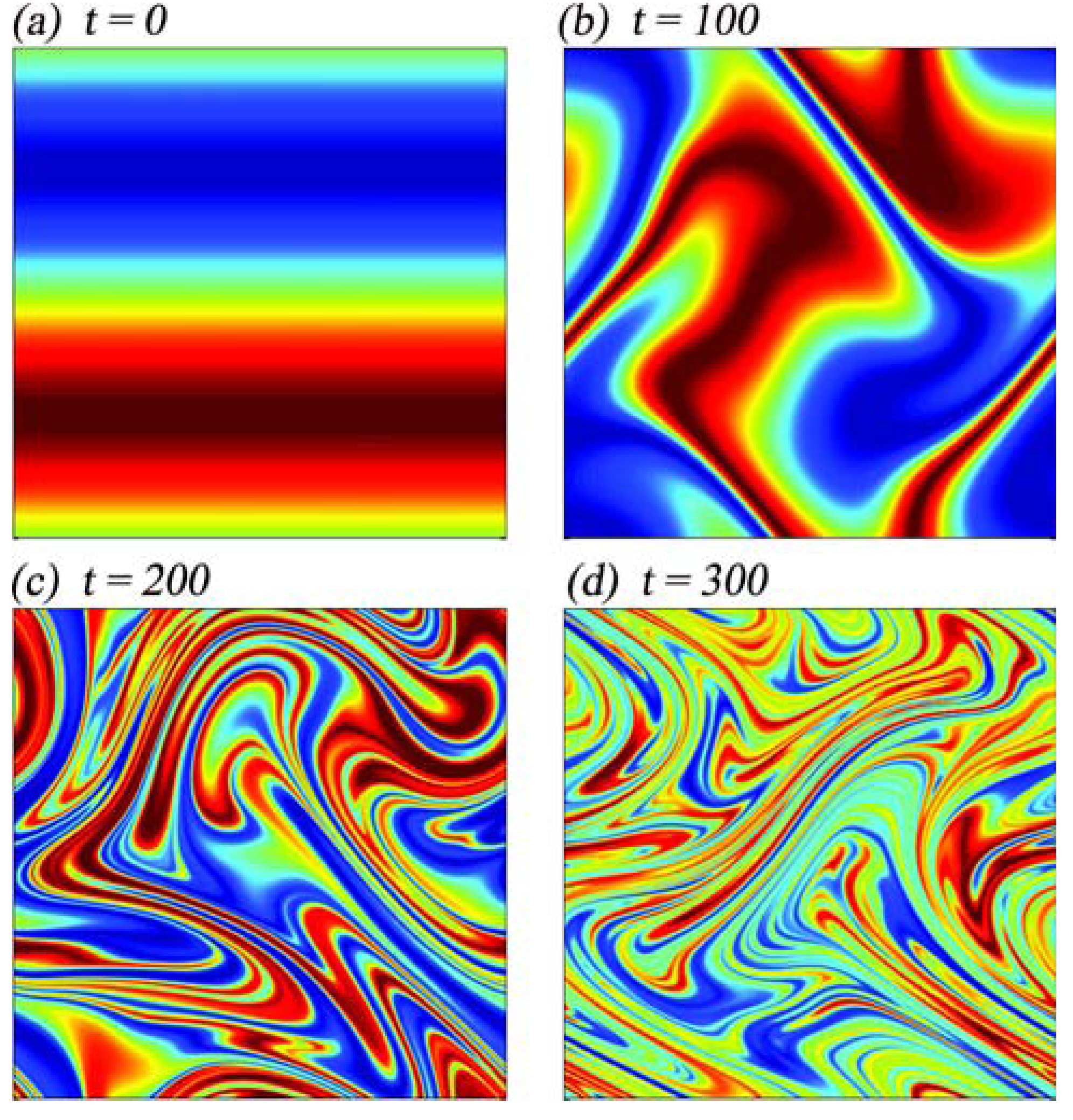Dynamics of Complex Fluids
Complex fluids are fluids -- usually Newtonian -- that have suspended
microstructure such as long-chain polymers, microscopic rods and
fibers, colloidal particles, or even swimming bacteria. Understanding
the mechanical responses of complex fluids is important to contemporary
problems -- micro-fluidic mixing, transport, separation -- in
engineering, physics, and biology. The interesting and difficult
character of these systems lies in their multi-scale reciprocal
coupling: immersed particles react to the large-scale fluid flow --
changing shape, changing direction of motion, orientation, stretching,
interacting -- and so produce fluid stresses that feed back and modify
the large-scale flow. Research on complex fluids within the CMCL
focusses on their dynamics both at the level of microstructure, and at
the macroscopic scale.
Dynamics of Active Suspensions
Suspensions of self-propelled particles, such as
swimming microorganisms, are known to undergo complex dynamics as a
result of hydrodynamic interactions. Understanding these dynamics are
important to the application of active particle suspensions, whether
synthetic or biological, to microfluidic mixing and transport. We
have developed both particle-based and continuum approaches to
simulating and analyzing active suspension dynamics.
For example, the figure at upper left shows a simulated dynamics of a
3D
suspension of self-locomoting rods. In agreement with previous
theoretical predictions, orientationally ordered suspensions of such
swimming particles are
found to be unstable at long wavelengths as a result of hydrodynamic
fluctuations. The long-time dynamics is one of system-scale isotropy,
short-range alignment, and rapid fluid mixing.
To extend our understanding of these dynamics, we
have also developed a hydrodynamic theory and applied to study linear
stability and the
nonlinear pattern formation. For isotropic
suspensions, we demonstrate the existence of an instability for the
active particle stress, in which
shear stresses are eigenmodes and grow exponentially at long scales.
Nonlinear effects are also
investigated using numerical
simulations in two dimensions. The long-time nonlinear behavior is
shown to be characterized by the
formation of strong density
fluctuations, which merge and breakup in time in a quasiperiodic
fashion. The figure at upper right shows that these complex motions
result in very efficient fluid mixing.
Other areas of study include the linear well-posedness of our continuum
theory, the development of a simulator for suspensions of non-slender
self-propelled bodies, and the hydrodynamic properties of
self-assembled helical swimmers.
For technical references see:
- Modeling
simple locomotors in Stokes flow
A. Kanevsky, M. Shelley and A.-K. Tornberg, to appear, Journal of Computational
Physics (2009)
- Instabilities,
pattern formation
and mixing in active suspensions
D. Saintillan and M. Shelley, Physics of Fluids 20, 123304 (2008)
- Instabilities
and pattern formation in
active particle suspensions:
Kinetic theory and continuum simulations
D. Saintillan and M. Shelley, Physical
Review Letters 100,
178103 (2008)
- Orientational
order and instabilities in suspensions of self-locomoting rods
D. Saintillan and M. Shelley, Physical Review Letters 99, 058102 (2007)
Transport and Mixing of Viscoelastic Fluids
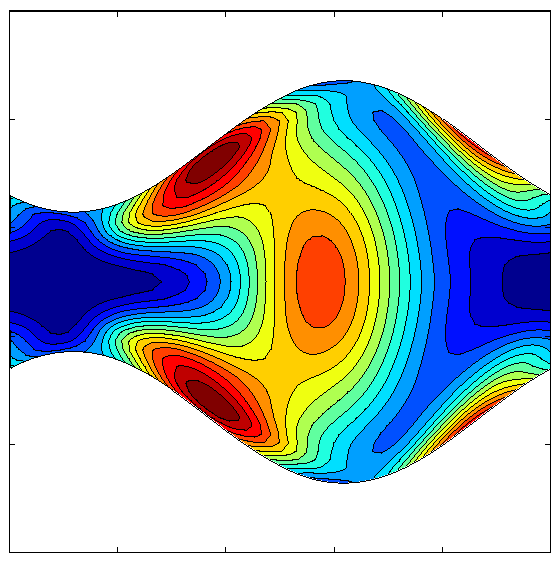
|
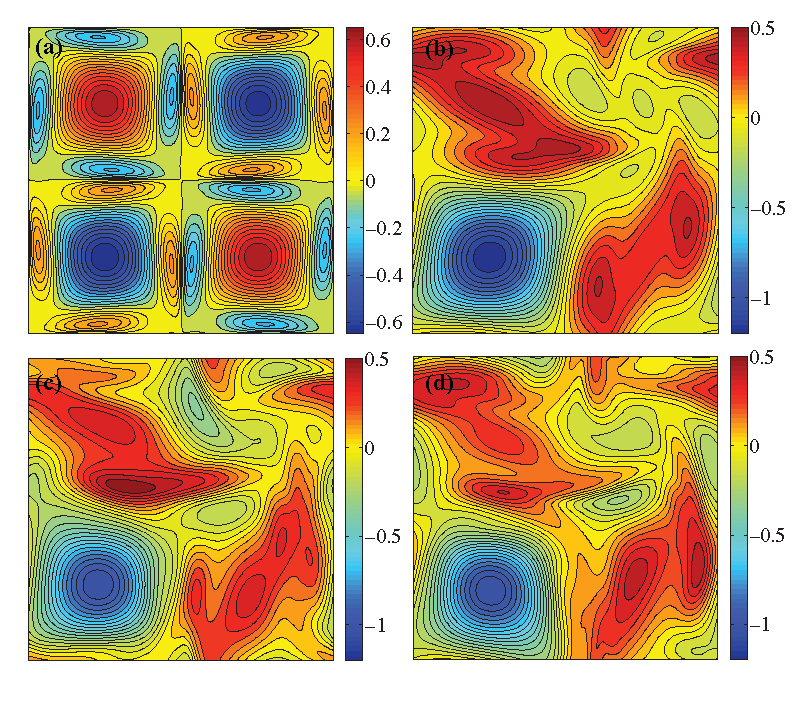
|
The dynamics of viscoelastic fluids is remains poorly
understood, even in the regime of low Reynolds number (Re), the common setting for many
biological and technological flows. An interesting aspect of
viscoelasticity is its introduction of nonlinearity and finite memory
to low Re flow, destroying
Stokes reversibility, and in some cases allowing behaviors more
reminiscent of high Re. We
have been studying the dynamics where these aspects are central.
The figure on upper left shows the development of
large normal stresses in a simulation of a viscoelastic fluid being
pumped through a channel by peristaltic waves. Peristalsis is a
fundamental mode of fluid transport in engineered and biological
systems. The normal stress develop on time-scales set by the
Weissenberg number (Wi, the
ratio of polymer relaxation time to the flow time-scale), and for
sufficiently large Wi can be
driven by a coil-stretch transition. Our simuation reveals that these
polymer stresses create large forces on the channel walls, and create a
strong reflux against the driven flow, severely decreasing the pump's
efficiency.
The figure at right shows that quasi-periodic mixing
dynamics can arise in viscoelastic flows, even at zero Re. This is a simulation of the
Oldroyd-B model where the fluid is being driven by a time-independent
force that in the absence of the polymer field, would create a
time-independent, four-roll mill vortical flow. Here the dynamics
follows from a symmetry-breaking instability that happens for
sufficiently large Wi.
Other areas of study include the simulation of 3D mixing dynamics, and
the swimming of undulating bodies in viscoelastic fluids.
For technical references see:
Dynamics of Fiber Suspensions
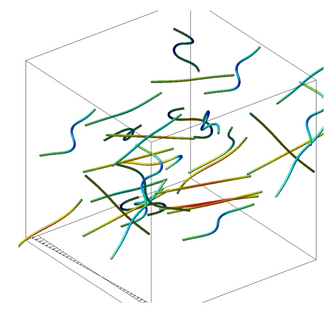
|
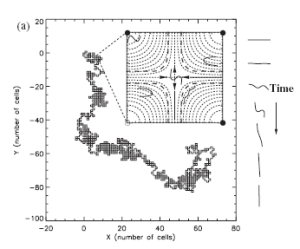
|
The understanding of the dynamics
of such fiber suspensions are
fundamental to understanding many flows arising in physics, biology
and engineering. Examples include fiber-reinforced composites, the
dynamics and rheology of biological polymers and the motility of
microscopic organisms. Such filaments often have aspect ratios of
length to radius ranging from a few hundred to several thousand. Full
discretizations of such thin objects in a 3D domain is very costly.
The Reynolds numbers for these applications typically
very low.
We have constructed simulation methods for multiple
flexible fibers immersed and interacting in a 3D Stokesian fluid. These
methods make explicit use of the special nature of the Stokes
equations, as well as the slenderness of the fibers. The key points are
that boundary integral methods can be employed to
reduce the three-dimensional dynamics to the dynamics of the
two-dimensional filament surfaces, and that using slender body
asymptotics, this can be further reduced to the dynamics of the
one-dimensional filament centerlines. The resulting intergral
equations take into account the fluid-filament interaction as well as
filament-filament interactions, as mediated by the fluid. The figure at
left shows the dynamics of many interacting fibers immersed in an
oscillating shear, a common rheological flow for measure the complex
moduli of elastic fluids. These fibers have undergone a buckling
instability kicked off by hydrodynamic interactions amongst them.
We have also uncovered new instabilities in fiber
suspensions that lead to microstructural transport. The figure at right
shows the wandering orbit of a flexible fiber immersed in a cellular
flow. At the heart of this dynamics is the stretch-coil instability, which is
the analog of the classical coil-stretch instability of polymeric
fluids. The stretch-coil instability is a buckling instability driven
by the compressional flows in the neighborhood of flow stagnation
points.
Other areas of studies include the
dynamics of rigid fiber suspensions, the development of fast summation
methods for many particle dynamics in the Stokes equations.
For technical references
see

